MENU
The Electronic Scholarly Publishing Project: Providing access to classic scientific papers and other scholarly materials, since 1993. More About: ESP | OUR CONTENT | THIS WEBSITE | WHAT'S NEW | WHAT'S HOT
Comparative Timelines
The ESP Timeline (one of the site's most popular features) has been completely updated to allow the user to select (using the timeline controls above each column) different topics for the left and right sides of the display.
Select:
New Left Column
New Left Column
Dates
Decade
New Right Column
New Right Column
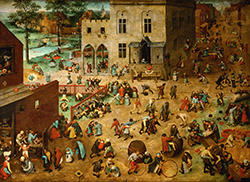 Painting by Pieter Bruegel the Elder: Children's Games The children, who range in age from toddlers to adolescents, roll hoops, walk on stilts, spin hoops, ride hobby-horses, stage mock tournaments, play leap-frog and blind man's bluff, perform handstands, inflate pigs' bladders and play with dolls and other toys. They have also taken over the large building that dominates the square: it may be a town hall or some other important civic building, in this way emphasizing the moral that the adults who direct civic affairs are as children in the sight of God. This crowded scene is to some extent relieved by the landscape in the top left-hand corner; but even here children are bathing in the river and playing on its banks. The artist's intention for this work is more serious than simply to compile an illustrated encyclopaedia of children's games, though some eighty particular games have been identified. Bruegel shows the children absorbed in their games with the seriousness displayed by adults in their apparently more important pursuits. His moral is that in the mind of God children's games possess as much significance as the activities of their parents.
Painting by Pieter Bruegel the Elder: Children's Games The children, who range in age from toddlers to adolescents, roll hoops, walk on stilts, spin hoops, ride hobby-horses, stage mock tournaments, play leap-frog and blind man's bluff, perform handstands, inflate pigs' bladders and play with dolls and other toys. They have also taken over the large building that dominates the square: it may be a town hall or some other important civic building, in this way emphasizing the moral that the adults who direct civic affairs are as children in the sight of God. This crowded scene is to some extent relieved by the landscape in the top left-hand corner; but even here children are bathing in the river and playing on its banks. The artist's intention for this work is more serious than simply to compile an illustrated encyclopaedia of children's games, though some eighty particular games have been identified. Bruegel shows the children absorbed in their games with the seriousness displayed by adults in their apparently more important pursuits. His moral is that in the mind of God children's games possess as much significance as the activities of their parents.
1560
(no entry for this year)
(no entry for this year)
1561
(no entry for this year)
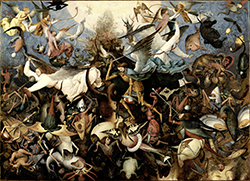 Painting by Pieter Bruegel the Elder: The Fall of the Rebel Angels The depiction of this subject is taken from a passage from the Book of Revelation (12, 2-9) and reveals the artist's profound debt to Hieronymous Bosch, especially in the grotesque figures of the fallen angels, shown as half-human, half-animal monsters. Together with Dulle Griet and The Triumph of Death, which have similar dimensions, it was probably painted for the same collector and destined to become part of a series.
Painting by Pieter Bruegel the Elder: The Fall of the Rebel Angels The depiction of this subject is taken from a passage from the Book of Revelation (12, 2-9) and reveals the artist's profound debt to Hieronymous Bosch, especially in the grotesque figures of the fallen angels, shown as half-human, half-animal monsters. Together with Dulle Griet and The Triumph of Death, which have similar dimensions, it was probably painted for the same collector and destined to become part of a series.
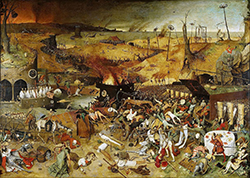 Painting by Pieter Bruegel the Elder: The Triumph of Death The painting shows a panorama of an army of skeletons wreaking havoc across a blackened, desolate landscape. Fires burn in the distance, and the sea is littered with shipwrecks. A few leafless trees stud hills otherwise bare of vegetation; fish lie rotting on the shores of a corpse-choked pond.
Painting by Pieter Bruegel the Elder: The Triumph of Death The painting shows a panorama of an army of skeletons wreaking havoc across a blackened, desolate landscape. Fires burn in the distance, and the sea is littered with shipwrecks. A few leafless trees stud hills otherwise bare of vegetation; fish lie rotting on the shores of a corpse-choked pond.
1562
(no entry for this year)
(no entry for this year)
1563
(no entry for this year)
(no entry for this year)
1564
(no entry for this year)
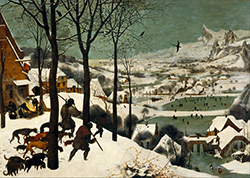 Painting by Pieter Bruegel the Elder: The Hunters in the Snow (Dutch: Jagers in de Sneeuw), also known as The Return of the Hunters, is a 1565 oil-on-wood painting by Flemish artist Pieter Bruegel the Elder. The Northern Renaissance work is one of a series of works, five of which still survive, that depict different times of the year. The Hunters in the Snow, and the series to which it belongs, are in the medieval and early Renaissance tradition of the Labours of the Months: depictions of various rural activities and work understood by a spectator in Breugel's time as representing the different months or times of the year.
Painting by Pieter Bruegel the Elder: The Hunters in the Snow (Dutch: Jagers in de Sneeuw), also known as The Return of the Hunters, is a 1565 oil-on-wood painting by Flemish artist Pieter Bruegel the Elder. The Northern Renaissance work is one of a series of works, five of which still survive, that depict different times of the year. The Hunters in the Snow, and the series to which it belongs, are in the medieval and early Renaissance tradition of the Labours of the Months: depictions of various rural activities and work understood by a spectator in Breugel's time as representing the different months or times of the year.
1565
Roger Taverner writes his Arte of Surveyinge.
 Painting by Giuseppe Arcimboldo: The Four Elements a series of paintings that were commissioned by Maximilian II, Holy Roman Emperor. The portraits display figures in profile formed by different animals or objects. Earth is represented by land animals, Air by birds, Water by marine creatures and Fire by burning wood and cannons. This series attempts to express harmony out of chaos with wild animals forming distinct faces. It also praises Maximilian, suggesting that he is a ruler who controls even the four primal elements.
Painting by Giuseppe Arcimboldo: The Four Elements a series of paintings that were commissioned by Maximilian II, Holy Roman Emperor. The portraits display figures in profile formed by different animals or objects. Earth is represented by land animals, Air by birds, Water by marine creatures and Fire by burning wood and cannons. This series attempts to express harmony out of chaos with wild animals forming distinct faces. It also praises Maximilian, suggesting that he is a ruler who controls even the four primal elements.
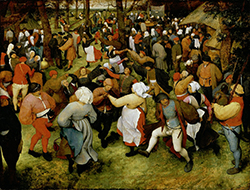 Painting by Pieter Bruegel the Elder: The Wedding Dance The painting depicts 125 wedding guests. As was customary in the Renaissance period, the brides wore black and men wore codpieces. Voyeurism is depicted throughout the entire art work; dancing was disapproved of by the authorities and the church, and the painting can be seen as both a critique and comic depiction of a stereotypical oversexed, overindulgent, peasant class of the times.
Painting by Pieter Bruegel the Elder: The Wedding Dance The painting depicts 125 wedding guests. As was customary in the Renaissance period, the brides wore black and men wore codpieces. Voyeurism is depicted throughout the entire art work; dancing was disapproved of by the authorities and the church, and the painting can be seen as both a critique and comic depiction of a stereotypical oversexed, overindulgent, peasant class of the times.
1566
(no entry for this year)
(no entry for this year)
1567
(no entry for this year)
(no entry for this year)
1568
(no entry for this year)
(no entry for this year)
1569
(no entry for this year)
ESP Quick Facts
ESP Origins
In the early 1990's, Robert Robbins was a faculty member at Johns Hopkins, where he directed the informatics core of GDB — the human gene-mapping database of the international human genome project. To share papers with colleagues around the world, he set up a small paper-sharing section on his personal web page. This small project evolved into The Electronic Scholarly Publishing Project.
ESP Support
In 1995, Robbins became the VP/IT of the Fred Hutchinson Cancer Research Center in Seattle, WA. Soon after arriving in Seattle, Robbins secured funding, through the ELSI component of the US Human Genome Project, to create the original ESP.ORG web site, with the formal goal of providing free, world-wide access to the literature of classical genetics.
ESP Rationale
Although the methods of molecular biology can seem almost magical to the uninitiated, the original techniques of classical genetics are readily appreciated by one and all: cross individuals that differ in some inherited trait, collect all of the progeny, score their attributes, and propose mechanisms to explain the patterns of inheritance observed.
ESP Goal
In reading the early works of classical genetics, one is drawn, almost inexorably, into ever more complex models, until molecular explanations begin to seem both necessary and natural. At that point, the tools for understanding genome research are at hand. Assisting readers reach this point was the original goal of The Electronic Scholarly Publishing Project.
ESP Usage
Usage of the site grew rapidly and has remained high. Faculty began to use the site for their assigned readings. Other on-line publishers, ranging from The New York Times to Nature referenced ESP materials in their own publications. Nobel laureates (e.g., Joshua Lederberg) regularly used the site and even wrote to suggest changes and improvements.
ESP Content
When the site began, no journals were making their early content available in digital format. As a result, ESP was obliged to digitize classic literature before it could be made available. For many important papers — such as Mendel's original paper or the first genetic map — ESP had to produce entirely new typeset versions of the works, if they were to be available in a high-quality format.
ESP Help
Early support from the DOE component of the Human Genome Project was critically important for getting the ESP project on a firm foundation. Since that funding ended (nearly 20 years ago), the project has been operated as a purely volunteer effort. Anyone wishing to assist in these efforts should send an email to Robbins.
ESP Plans
With the development of methods for adding typeset side notes to PDF files, the ESP project now plans to add annotated versions of some classical papers to its holdings. We also plan to add new reference and pedagogical material. We have already started providing regularly updated, comprehensive bibliographies to the ESP.ORG site.
ESP Picks from Around the Web (updated 06 MAR 2017 )
Old Science

Weird Science

Treating Disease with Fecal Transplantation
Fossils of miniature humans (hobbits) discovered in Indonesia

Dinosaur tail, complete with feathers, found preserved in amber.
Astronomy

Mysterious fast radio burst (FRB) detected in the distant universe.